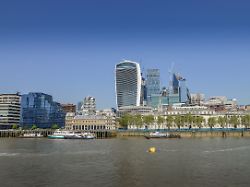From Shanghai to San Francisco, more people have been working from home since the pandemic. Due to the empty offices in the office towers around the world, a gigantic wave of losses is rolling towards the industry. But for many inner cities, this may be good news.
The ongoing trend towards hybrid working from the office and from home could lead to a massive drop in the value of commercial real estate around the world in the coming years. According to a study by the McKinsey Global Institute, the owners of the skyscrapers are threatened in the largest metropolises in the world by 2030 due to increasing vacancies and falling rents, losses of up to 800 billion dollars.
The reason for this is the change in the world of work after the corona pandemic: Because more and more people around the world are working remotely and come to the office less often, more and more space is empty. Falling demand is depressing rents and real estate values in all nine cities analyzed by McKinsey, including New York, Beijing, London and Munich.
The impending loss of value of 800 billion dollars represents only the moderate scenario that the consultants have modeled: The valuation of office towers will fall by an average of 26 percent by 2030 compared to 2019. In the worst case, however, there could also be a slump of up to 42 percent if employees in all sectors stay away from the office to the same extent as is already the case in large tech companies. The loss in value could also be “even greater if it is exacerbated by rising interest rates,” writes McKinsey. Or “when distressed financial institutions lower the price of buildings they own or finance more quickly.”
No going back to before the pandemic
In any case, McKinsey assumes that the real estate market will not return to the level before the corona pandemic for decades because the working world has changed permanently: According to the study, employees come 30 percent less often to the office. In addition, millions of people fled to the suburbs during the pandemic: New York city center lost around five percent of its residents, in San Francisco it was six percent. Even in the moderate scenario, demand for office space will therefore be 13 percent lower by 2030 than in 2019.
But the crash is different in many cities: while San Francisco (-22.4 percent) or New York (-17.6 percent) are rapidly declining, the slump in demand is falling in Munich (-10.5 percent) and Paris (-8.2 percent), Tokyo (-7.4 percent) and Shanghai (-5.9 percent) are less than half the size. On the one hand, this is due to the work culture: In Japan, employees are expected to be much more present in the office than in Europe, for example, as the survey data from the study show.
But also due to the different urban structure: In the inner cities of London, Dallas, New York and San Francisco there is a very high office density and many employees work in service and tech professions. In contrast, office space, residential buildings and shopping facilities exist side by side in European and Japanese metropolises. As a result, there is less population loss and home office commuters.
The crash could revitalize inner cities
Cities with mixed inner-city use are noticeably better able to cope with the new reality in the world of work. According to McKinsey, the conversion of empty office space could therefore be the solution for real estate values in many European cities and office metropolises such as San Francisco or New York: When planning quarters, buildings and floor plans, “go for diversity, adaptability and flexibility instead of homogeneity decisions can help cities thrive.”
The real estate crash that may be coming could be a blessing for inner cities. For revitalization, the consultants recommend hybrid, modular buildings that can be quickly converted to commercial or residential use, as well as converting vacant office space into hotels, schools and apartments. However, the hurdles – development plans, existing leases and size limits – are high.
In addition, the conversion of buildings is not a panacea: Even if all vacant offices were converted into living space, the stock of residential buildings in each city would grow by less than three percent on average. For office owners, who otherwise face falling rents and vacancies, this could still be the lesser evil.
